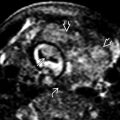KEY FACTS
Terminology
- •
Fibroid, leiomyoma
- •
Definition: Benign smooth muscle tumor of uterus
Imaging
- •
Typically well-defined round or oval hypoechoic mass ± calcification
- •
Myomas can grow during first 1/2 of pregnancy
- •
Myomas can degenerate during pregnancy
- ○
Most common: Asymptomatic hyaline degeneration
- –
Typically heterogeneous, septated, cystic myoma
- –
- ○
Less common: Symptomatic hemorrhagic degeneration
- –
Hyperechoic, heterogeneous, solid-appearing myoma
- –
Can lead to preterm labor and pregnancy loss
- –
- ○
- •
Placenta can implant upon myoma
- •
Color Doppler findings
- ○
Uterine vessels supply myoma
- –
May see vascular pedicle to pedunculated myoma
- –
- ○
Peripheral swirled pattern of flow is typical
- ○
Clinical Issues
- •
Complications related to size, number, and location
- ○
Lower uterine myoma with ↑ rates of malpresentation, cesarean delivery, and postpartum hemorrhage
- ○
Retroplacental myoma with ↑ rates of placental insufficiency, abruption, and preterm labor
- ○
Multiple myomas associated with fetal growth restriction and postpartum hemorrhage
- ○
- •
Acute pain, low-grade fever associated with hemorrhagic degeneration: MR best to show hemorrhage
Scanning Tips
- •
Note location, type, and size of myoma in every case
- •
Note relationship with placenta and cervix
- •
Adnexal and pedunculated myoma can mimic ovarian mass
- ○
Look for blood supply from uterus
- ○
Look for separate ovary
- ○
- •
If myoma is painful, consider hemorrhagic degeneration and alert provider
 implants upon a submucosal myoma
implants upon a submucosal myoma  . The myoma is homogeneous and hypoechoic. Placental implantation upon myoma is associated with abruption and fetal growth restriction.
. The myoma is homogeneous and hypoechoic. Placental implantation upon myoma is associated with abruption and fetal growth restriction.
 is implanted upon a myoma
is implanted upon a myoma  , demonstrating typical swirled flow pattern on color Doppler. This is probably why a marginal abruption
, demonstrating typical swirled flow pattern on color Doppler. This is probably why a marginal abruption  occurred in this pregnancy.
occurred in this pregnancy.
 , the avascular central cystic region and wall nodularities
, the avascular central cystic region and wall nodularities  mimic an ovarian neoplasm. However, the myoma blood supply is shown coming from the uterus
mimic an ovarian neoplasm. However, the myoma blood supply is shown coming from the uterus  and a separate normal ovary was documented (not shown).
and a separate normal ovary was documented (not shown).
 . Note the internal septations and wall nodularity
. Note the internal septations and wall nodularity  . Smaller uncomplicated solid fibroids
. Smaller uncomplicated solid fibroids  are also seen.
are also seen.
Stay updated, free articles. Join our Telegram channel

Full access? Get Clinical Tree








